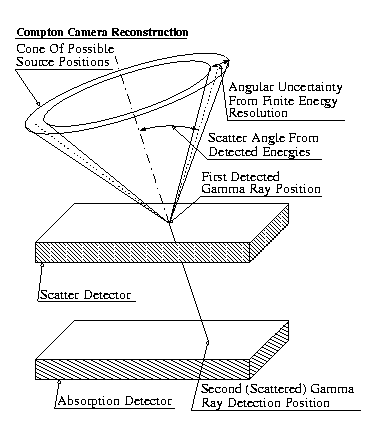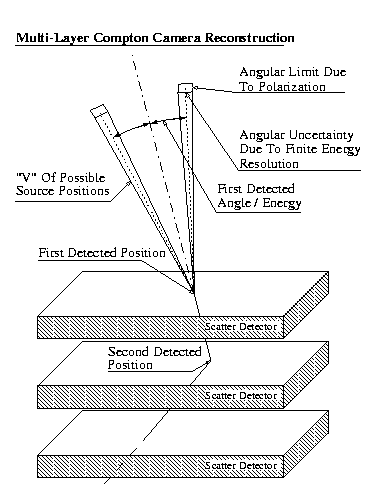
Investigation into a Compton Camera
The primary limitation in SPECT imaing is in the poor spatial
resolution and high patient dosage. This is required so that enough counts
can be detected by the camera in order to provide a statistically accurate
image. The typical lead collimator allows only 1 in 10,000 photons emitted
from the patient to be detected. Thus, without the collimator the performance
of the system should improve substantially. This may be achieved by using
a Compton camera.
The Compton Camera
The potential gains that the Compton camera offers over the
Anger Camera are primarily due to the absence of the lead collimator. This
is expected to (i) give great gains in system sensitivity, and (ii) allow
the acquisition of data representing multiple angular views of the source
distribution from a single position; reducing the necessary camera motion.
Both these effects may reduce the radiation dose delivered
to the patient in order to produce a useful image. First, the systems increased
sensitivity will allow the use of lower activity levels and/or isotopes
with shorter half-lives. Secondly, the reduced angular motion of the camera
will result in less wasted time between angular stops. The mechanical complexity
of the system will also be reduced because of the abscence of the massive
lead collimator.
Compton cameras are in current use in the nuclear energy
industry for site and environmental surveys.
Principle of operation
 The generic
Compton camera design consists of 2 detectors. The function of the first
detector is to promote and to detect Compton interactions. This is commonly
referred to as the "scatter detector". Si, Ge and Ar have all been proposed
and experimented with as scatter detector materials, primarily due to their
high Compton scatter cross-sections in the 100-600 KeV range.
The generic
Compton camera design consists of 2 detectors. The function of the first
detector is to promote and to detect Compton interactions. This is commonly
referred to as the "scatter detector". Si, Ge and Ar have all been proposed
and experimented with as scatter detector materials, primarily due to their
high Compton scatter cross-sections in the 100-600 KeV range.
The second detector is referred to as the "absorbtion
detector". As the name suggests, its function is to absorb scattered gamma
rays, measuring both position and energy. Typical choices for this detector
are CdZnTe, NaI, BGO and Xe, due to their high photo-absorbtion cross-sections
in the energy range of interest.
Although NaI and BGO detectors have worse energy and
position resolutions than their solid state and gas couterparts, they were
the first absorbtion detector materials investigated, and continue to be
considered. This is because they are already in wide use in SPECT cameras.
This could allow the development of a "Compton camera add-on" to convert
existing cameras at low cost.
Because the exact energy of the photons emitted by the
radioisotope is known, the sum of the energies deposited in the scatter
and absorption detectors is used to reject photons that do not offer accurate
information about their source because of scattering within the patient
or other effects. The probability of the photon scattering though a given
angle is described by the Klein-Nishina formula. This formula also relates
the energy deposited in the scatter detector to the angle through which
the photon was scattered.
 The
positions of the interactions, coupled with the scatter angle, limits the
photon's possible source location to a cone whose axis is in line with
the positions of the two interactions, and whose opening angle is equal
to the scatter angle. Uncertainties in the positions and energies of the
interactions give the cone of possible source locations a non-zero thickness.
The
positions of the interactions, coupled with the scatter angle, limits the
photon's possible source location to a cone whose axis is in line with
the positions of the two interactions, and whose opening angle is equal
to the scatter angle. Uncertainties in the positions and energies of the
interactions give the cone of possible source locations a non-zero thickness.
This type of information about the possible source distribution
requires specialized reconstructions techniques. These techniques are under
investigation by a number of research groups, including ours.
Solid State and Solid State / Scintillation Compton Cameras
Solid state detectors are being investigated for use in compton
cameras because of their high energy and spatial resolution compared to
scintillation crystals. As stated earlier, Si is the best solid-state choice
for the scatter detector.
Solid state detectors require more supporting electronics
than scintillation or gas detectors because each pixel in the detector
uses it's own readout channel.
Si detectors are also very sensitive to thermal noise,
and require cooling in order to operate at acceptable levels of energy
resolution.
Solid state detectors usually have a smaller field of
view (approx. 10 cm) than existing anger cameras (50 cm).
Si detectors are limited to approximately 5 mm thickness
because of the technical challenges and costs involved in making them thicker.
Thicker Ge detectors can be produced without much trouble, but it's less
than ideal because of its high photoelectric cross-section.
The possibility of using Si strip detectors "edge-on"
has been proposed by Beauville, Collins, Kipins, Nygren, Oltmann and Hauptman.
This would present a greater apparent thickness to the gamma source, and
allow much greater efficiency of detection. The number of read-out channels
would be extremely high for this approach, complicating the electronics
of the detector.
 Another
approach is to stack multiple layers of Si detectors. This type of "multi-layer"
Compton camera would allow the possibility of the photon scattering more
than once before it is absorbed. This kind of thing is referred to as a
three(or more) - vertex event.
Another
approach is to stack multiple layers of Si detectors. This type of "multi-layer"
Compton camera would allow the possibility of the photon scattering more
than once before it is absorbed. This kind of thing is referred to as a
three(or more) - vertex event.
In three(or more)-vertex events, the possibility of using
knowledge of the gamma photon's polarization is being investigated by Basko,
Zeng, and Gullberg. They say that this could reduce to cone of possible
source positions to a "V", because all scatters after the first will lie
in the plane of the photon's polarization.


 The generic
Compton camera design consists of 2 detectors. The function of the first
detector is to promote and to detect Compton interactions. This is commonly
referred to as the "scatter detector". Si, Ge and Ar have all been proposed
and experimented with as scatter detector materials, primarily due to their
high Compton scatter cross-sections in the 100-600 KeV range.
The generic
Compton camera design consists of 2 detectors. The function of the first
detector is to promote and to detect Compton interactions. This is commonly
referred to as the "scatter detector". Si, Ge and Ar have all been proposed
and experimented with as scatter detector materials, primarily due to their
high Compton scatter cross-sections in the 100-600 KeV range.
 The
positions of the interactions, coupled with the scatter angle, limits the
photon's possible source location to a cone whose axis is in line with
the positions of the two interactions, and whose opening angle is equal
to the scatter angle. Uncertainties in the positions and energies of the
interactions give the cone of possible source locations a non-zero thickness.
The
positions of the interactions, coupled with the scatter angle, limits the
photon's possible source location to a cone whose axis is in line with
the positions of the two interactions, and whose opening angle is equal
to the scatter angle. Uncertainties in the positions and energies of the
interactions give the cone of possible source locations a non-zero thickness.
 Another
approach is to stack multiple layers of Si detectors. This type of "multi-layer"
Compton camera would allow the possibility of the photon scattering more
than once before it is absorbed. This kind of thing is referred to as a
three(or more) - vertex event.
Another
approach is to stack multiple layers of Si detectors. This type of "multi-layer"
Compton camera would allow the possibility of the photon scattering more
than once before it is absorbed. This kind of thing is referred to as a
three(or more) - vertex event.

